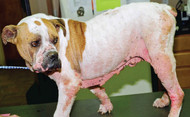Canine Atopic Dermatitis
Posted by Essential Dog on Mar 16, 2023
Canine atopic dermatitis (CAD) is a chronic allergic skin disease that affects dogs. It is a common condition and is estimated to affect up to 10% of the dog population. CAD is caused by a hypersensitive reaction to environmental allergens such as dust mites, pollen, and molds, and can manifest in various ways, including itching, redness, swelling, and recurrent skin infections.
Causes of CAD
The exact cause of CAD is not well understood, but it is believed to result from a combination of genetic and environmental factors. Dogs with a genetic predisposition to CAD have a weakened skin barrier, which makes them more susceptible to allergens. Environmental factors such as pollution and exposure to allergens in the home can also contribute to the development of the disease.
Symptoms of CAD
Symptoms of CAD typically begin to manifest between the ages of 6 months and 3 years, and the condition tends to worsen with age. It is more prevalent in certain breeds, including Terriers, Retrievers, Bulldogs, and Setters, among others.
The symptoms of CAD can vary from dog to dog and may include itching, redness, swelling, and hair loss. The most common sign of CAD is itching, which can be severe and may lead to self-trauma, resulting in secondary skin infections. These infections can cause further discomfort and may require additional treatment.
Diagnosing CAD can be challenging as it shares similarities with other skin conditions such as flea allergies, dermatitis and food allergies. A thorough medical history, physical examination, and diagnostic tests such as skin scrapings and blood tests may be required to rule out other causes of skin irritation. Skin biopsy may also be necessary to confirm the diagnosis.
CAD Treatment
Treatment for CAD focuses on managing symptoms and preventing flare-ups. This can be achieved through a combination of medication and lifestyle changes. Medications such as corticosteroids, antihistamines, and immune-modulating drugs can help alleviate itching and inflammation but if you want to use natural topical treatments such as our shampoos, sprays, and creams can also help soothe irritated skin.
Lifestyle changes can also play a significant role in managing CAD. Identifying and avoiding environmental allergens, such as dust mites and pollen, can help reduce the frequency and severity of symptoms. Regular bathing with specialised shampoos can also help remove allergens from the skin and coat.
Conclusion
In conclusion, CAD is a chronic allergic skin disease that affects many dogs. It is caused by a hypersensitivity reaction to environmental allergens and can manifest in various ways, including itching, redness, swelling, and recurrent skin infections. Treatment focuses on managing symptoms and preventing flare-ups through a combination of medication and lifestyle changes. With proper management, many dogs with CAD can lead happy and comfortable lives.

